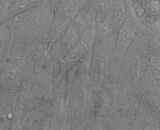Thymic Fibroblasts (TF)
Thymic Fibroblast Cells

Fibroblasts have been extensively used for a wide range of cellular and molecular studies as they are one of easiest types of cells to grow in culture. Their durability also makes them amenable to a variety of manipulations ranging from studies employing gene transfection to microinjection. In general, fibroblasts secrete a non-rigid extracellular matrix which is rich in type I and/or type III collagen . There is evidence showing that fibroblasts in various organs are intrinsically different. The thymic fibroblasts (TF) are derived from the embryonic neural crest, which first surrounds the thymus as mesenchyme and later migrates into the thymic epithelium to form a network of fibroblasts. Thymic fibroblasts and the associated extracellular matrix have been shown to be responsible for normal thymus morphogenesis and lymphopoiesis.
Organism species: Homo sapiens (Human)
- Cell CSI036Hu01 Primary Human Thymic Fibroblasts (TF) In Stock
- Customized Service n/a Extract of Thymic Fibroblasts (TF) Total Protein/DNA/RNA Extract Customized Service Offer
- Customized Service n/a Medium for Thymic Fibroblasts (TF) (If Necessary) Cell Culture Medium Customized Service Offer
Organism species: Mus musculus (Mouse)
- Cell CSI036Mu01 Primary Mouse Thymic Fibroblasts (TF) In Stock
- Customized Service n/a Extract of Thymic Fibroblasts (TF) Total Protein/DNA/RNA Extract Customized Service Offer
- Medium MSI036Mu11 Medium for Mouse Thymic Fibroblasts (TF) In Stock
Organism species: Rattus norvegicus (Rat)
- Cell CSI036Ra01 Primary Rat Thymic Fibroblasts (TF) In Stock
- Customized Service n/a Extract of Thymic Fibroblasts (TF) Total Protein/DNA/RNA Extract Customized Service Offer
- Medium MSI036Ra11 Medium for Rat Thymic Fibroblasts (TF) In Stock
Organism species: Oryctolagus cuniculus (Rabbit)
- Cell CSI036Rb01 Primary Rabbit Thymic Fibroblasts (TF) In Stock
- Customized Service n/a Extract of Thymic Fibroblasts (TF) Total Protein/DNA/RNA Extract Customized Service Offer
- Medium MSI036Rb11 Medium for Rabbit Thymic Fibroblasts (TF) In Stock
Organism species: Felis catus; Feline (Cat)
- Cell CSI036Fe01 Primary Feline Thymic Fibroblasts (TF) In Stock
- Customized Service n/a Extract of Thymic Fibroblasts (TF) Total Protein/DNA/RNA Extract Customized Service Offer
- Medium MSI036Fe11 Medium for Feline Thymic Fibroblasts (TF) In Stock
Organism species: Canis familiaris; Canine (Dog)
- Cell CSI036Ca01 Primary Canine Thymic Fibroblasts (TF) In Stock
- Customized Service n/a Extract of Thymic Fibroblasts (TF) Total Protein/DNA/RNA Extract Customized Service Offer
- Medium MSI036Ca11 Medium for Canine Thymic Fibroblasts (TF) In Stock
Organism species: Sus scrofa; Porcine (Pig)
- Customized Service n/a Thymic Fibroblasts (TF) Primary Cells Customized Service Offer
- Customized Service n/a Extract of Thymic Fibroblasts (TF) Total Protein/DNA/RNA Extract Customized Service Offer
- Customized Service n/a Medium for Thymic Fibroblasts (TF) (If Necessary) Cell Culture Medium Customized Service Offer
Organism species: Bos taurus; Bovine (Cattle)
- Customized Service n/a Thymic Fibroblasts (TF) Primary Cells Customized Service Offer
- Customized Service n/a Extract of Thymic Fibroblasts (TF) Total Protein/DNA/RNA Extract Customized Service Offer
- Customized Service n/a Medium for Thymic Fibroblasts (TF) (If Necessary) Cell Culture Medium Customized Service Offer
Organism species: Capra hircus; Caprine (Goat)
- Cell CSI036Cp01 Primary Caprine Thymic Fibroblasts (TF) In Stock
- Customized Service n/a Extract of Thymic Fibroblasts (TF) Total Protein/DNA/RNA Extract Customized Service Offer
- Medium MSI036Cp11 Medium for Caprine Thymic Fibroblasts (TF) In Stock


